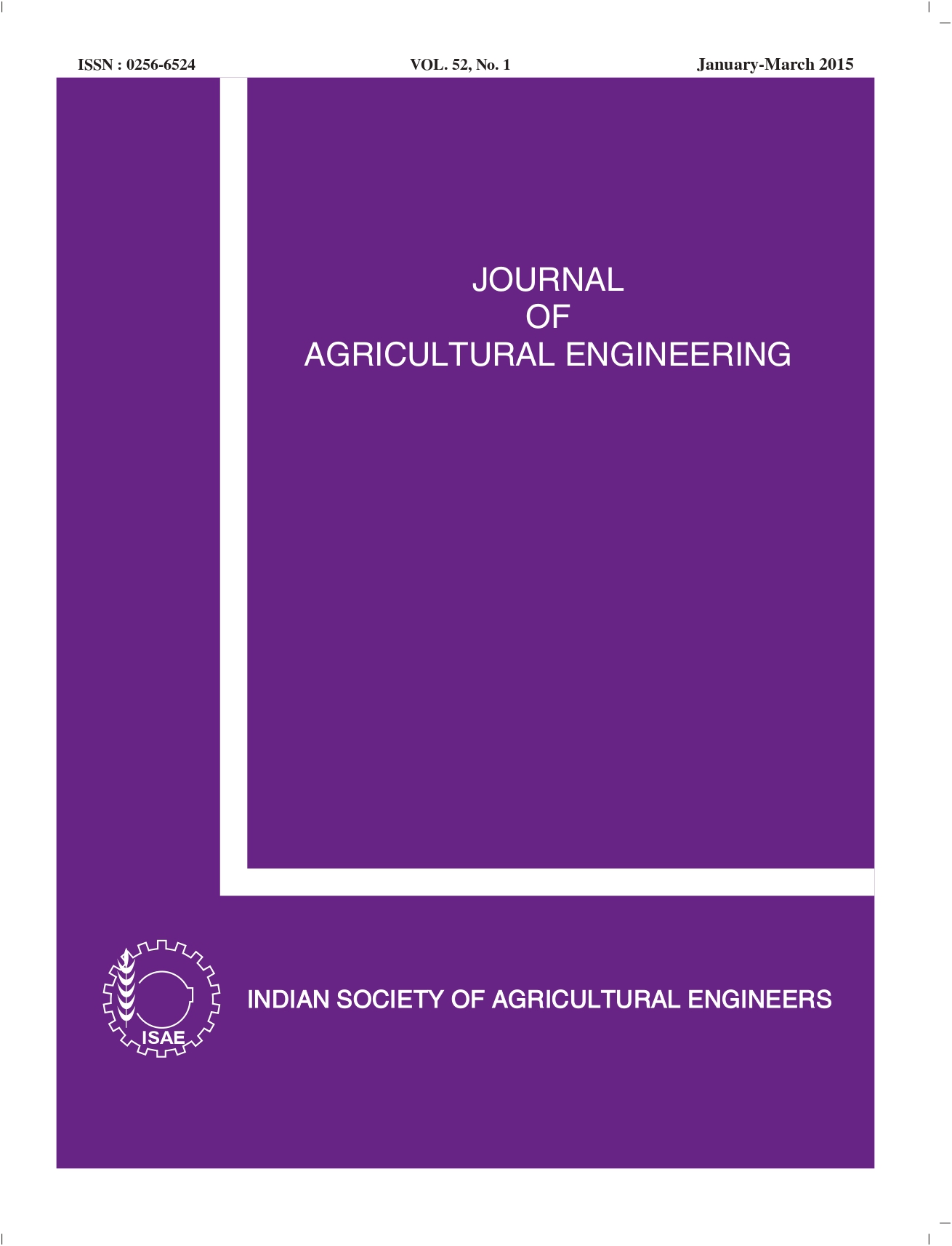Spatial Assessment of Wastewater Quality of Nag River for Irrigation
DOI:
https://doi.org/10.52151/jae2015521.1569Keywords:
Industrialization, wastewater quality, drains, irrigation, rainy, winter and summer season, BIS guidelinesAbstract
Rapid industrialization and overpopulation have stimulated increase in both domestic and industrial wastewater. Due to lack of efficient sewerage system and absence of treatment plants, the wastewater is discharged into drainage systems causing environmental and health implications. At various points, the wastewater of these drains is used for irrigation purposes. A study conducted at Nagpur during 2012-13 characterizes the effluent of major drains of Nagpur city and assess its suitability for irrigation. Temporal and spatial wastewater samples were collected from drains in rainy, winter and summer seasons during morning, afternoon; and evening and analysed for various parameters of special concern to irrigation. TSS, TDS, BOD, COD, N, P, EC, pH, micronutrient like Zn, Mn, Cu, Fe and heavy metals Co, Cd ,Cr and Pb varied in concentration at different locations at different time and seasons when compared with BIS and FAO guidelines for irrigation. Regular monitoring and proper treatment of wastewater before discharging into the drains can reduce the pollution in these drains. As the sewage water contains pollutants at higher levels, its direct use for irrigation and other purpose should be restricted.
References
Afzal S; Ahmad I; Younas M; Zahid M D; Atique K M H; Ijaz A; Ali K. 2000. Study of water quality of Hudiara Drain, India-Pakistan. Environ. Int., 26(1-2), 87-96. doi:10.1016/S0160-4120(00)00086-6
Akhtar S; Mohammad N. 2012. Impact of water quality on aquatic life in river Ravi. Pakistan J. Nature Environ. Pollution Tech., 11(2), 219-224.
APHA. 1985. APHA (American Public Health Association), Standard methods for the examination of water and wastewater, 19th ed., Washington, DC.
Ensink J H J; Van der Hoek W; Simmons Robert W. 2008. Livelihoods From Wastewater: Water Reuse in Faisalabad, Pakistan. IWA Publishing, London, pp. 387-400.
Hamid Almas; Zeb M; Mehmood A; Akthar S; Safim S. 2013. Assessment of Wastewater Quality of Drains for Irrigation. J. Environ. Protection, 4, 937-945.
Ibrahim M; Salamon S. 1992. Chemical composition of Faisalabad city sewage effluent: II Irrigation Quality.J. Agric. Res., (30), 391-340.
Kahlown A M; Ashraf M; Hussain M; Salam A H; Bhatti Z A. 2006.Impact assessment of sewerage and industrial effluents on water resources, soil, crops and human health in Faisalabad. Pakistan Council of Research in Water Resources, Lahore, pp: 1-105.
Mara D; Cairncross S. 1989. Guidelines for safe use of wastewater and excreta in agriculture and aquaculture. W.H.O, pp:205.
Naeem E. 2009. An investigation of the characteristics of effluent mixing in stream. University of Engineering and Technology, Taxila, pp: 144-146.
Nashikkar V J; Shende G B. 1998. Effect of long term varying levels of BOD of irrigation waters on crops. Resour. Conserv. Recycling, 1,131-136.
Page A L; Miller R H; Keemey D R. 1982. Methods of Soil Analysis. 2nd Edn., Amer. Soc. Agron., Madison, WI., USA.
Pay D; Christopher A S; Raschid S L; Mark R; Akiça B.2010. Wastewater irrigation and health: Assessing and mitigating risk in low-income countries. In: Non-Pathogenic Trade-Offs of Wastewater Irrigation, Earths-can, London, pp: 101-126.
Sahu K R; Katiyar S; Tiwari J; Kisku C G. 2007. Assessment of drain water receiving effluent from tanneries and its impact on soil and plants with particular emphasis on bioaccumulation of heavy metals. J. Environ. Bio., 28 (3), 685- 690.
SFWF. 2002. TDS and pH. Organization of Safe Drinking Water, Canada, pp: 1-6.
Sharma K R; Agrawal M; Marshall F. 2007.Heavy metal contamination of soil and vegetables in suburban areas of Varanasi, India. Ecotoxicology Environ. Safety, 66(2), 258-266. doi:10.1016/j.ecoenv.2005.11.007
Strauss M; Blumenthal U. 1990. Human Waste Use in Agriculture and Aquaculture: Utilization Practice and Health Perspectives. IRCWD Report 09/90, International Reference Centre for Waste Disposal, Duebendorf, Germany.
Tariq M; Ali M; Shah Z. 2006. Characteristics of industrial effluents and their possible impacts on quality of underground water. Soil Environ., 25(1), 64-69.
Thornton I; Butler D; Docx P; Hession M; Makro-poulos C; McMullen M; Nieuwenhuijsen M; Pitman A; Rautiu R; Sawyer R; Smith S; White D. 2006.Pollutants in urban wastewater and sewage sludge. Final Report, European Union, London, pp: 1-244.
WWF. 2007. Pakistan’s waters at risk: Water & Health Related Issues in Pakistan & Key Recommendations: A Special Report. WWF, Lahore, pp: 1-25.














